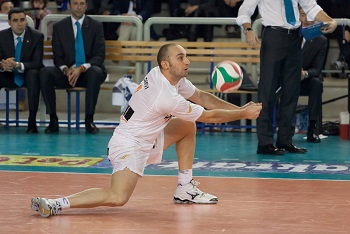Good serve receive skills are critical for running a team offense.
Perhaps the most important and often overlooked skill is the skill of communicating with teammates.
Communicating while Receiving the Serve
Serve Receive Communication
It doesn’t matter how great your passing skills are if you can’t decide who takes the ball.
In order to receive, the passers need to pass the ball accurately to a setter.
How well a team communicates will often determine how well a team passes in reception.
Communication skills are tied closely with anticipation skills.
For example, the better a team is at anticipating the serve, the sooner players will communicate with one another.
The earlier the communication, the easier it is to pass.
The following are important communication tips.
- Decide before the serve who takes what. As a player, know what ball you are responsible for. Do you have short? What about deep serves? Who’s the primary passer on your team? You may have different responsibilities in each rotation. Know what area of the court you are responsible for before the serve. This will make deciding what to do a lot easier.
- Practice calling the ball. Practice communicating on each serve. Practice calling the ball “mine”, calling “in” or “out”, and listening to your teammates. The better you get at understanding the language each teammate uses, the easier it will be to pass.
- Practice reading servers. A lot of information can be used from watching the server. Watch the server before they serve. Ask yourself what are their tendencies. Where did they serve the time before? What do they like to serve? Where don’t they like to serve? All these things help make the opponent more predictable and help with team communication.

Serve Receive Forearm Passing
Of all the reception skills, forearm passing is probably the most popular.
This is the technique the player uses to direct the ball with the forearms to team setter.
Mastering the Volleyball Bump Pass
The following are forearm passing tips.
- Start in a ready position with knees slightly bent and hands out in front.
- As you react to the served ball, focus on beating the ball to the spot with the feet.
- Get the platform out early when preparing to pass.
- Stay low and absorb the ball without swinging the arms.
- For deep serves, shuffle backwards quickly. Get the platform out early and angle the arms to the target area.
If you enjoyed these serve receive tips and would like to keep it close to you at any time, just save this pin to your Pinterest Volleyball Training Board.

Overhead Passing
The overhead pass is like a handset. The overhead pass is a more accurate pass, especially when the passer has plenty of time to get in position.
Overhead Volleyball Passing
What’s difficult about the overhead pass is it’s often tougher to make good consistent passes.
Most youth players struggle overhead passing because it’s harder to get in the best position to pass accurately.
For example, if the ball is served low and fast, it’s tough for a passer to get under the ball to overhead set.
Also on balls served to the side of the passer. It’s hard to move side ways and get in a comfortable position to take the ball overhead.
Then also on deep serves. It can be tough to pass deep serves because the player needs to be strong and athletic enough to get the ball to the target.
Home › How to Play › Receive
